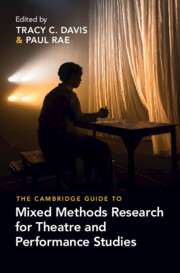Book contents
- The Cambridge Guide to Mixed Methods Research for Theatre and Performance Studies
- Reviews
- The Cambridge Guide to Mixed Methods Research for Theatre and Performance Studies
- Copyright page
- Contents
- Figures
- Tables
- Contributors
- Acknowledgements
- Introduction:
- Part I Planning
- Chapter 1 Methods Dialogue:
- Chapter 2 Planning a Research Project:
- Chapter 3 Interdisciplinary Acts:
- Chapter 4 Mixing Methods in a Multi-Sited, Collaborative Project:
- Chapter 5 Methods Dialogue:
- Part II Doing
- Part III Interpreting
- Index
- References
Chapter 1 - Methods Dialogue:
Difference
from Part I - Planning
Published online by Cambridge University Press: 01 February 2024
- The Cambridge Guide to Mixed Methods Research for Theatre and Performance Studies
- Reviews
- The Cambridge Guide to Mixed Methods Research for Theatre and Performance Studies
- Copyright page
- Contents
- Figures
- Tables
- Contributors
- Acknowledgements
- Introduction:
- Part I Planning
- Chapter 1 Methods Dialogue:
- Chapter 2 Planning a Research Project:
- Chapter 3 Interdisciplinary Acts:
- Chapter 4 Mixing Methods in a Multi-Sited, Collaborative Project:
- Chapter 5 Methods Dialogue:
- Part II Doing
- Part III Interpreting
- Index
- References
Summary
To ask ‘how do you do what you do?’ is both a technical and personal question. Brandi Wilkins Cantanese, Nicola Mārie Hyland, and Ben Spatz complicate the idea that methods are separable from researchers’ lives, while advocating for decolonizing research. Methods implicate both what and when: they are immanent in everything the scholar does. Exploring methods that gather information in relational and communal ways, the conversants reflect on how using various media in performance research (re-)contextualizes methods and the binary between bodily presence and recorded acts. They conclude that interdisciplinary research should invest in decolonizing methodologies as an ethical practice that both augments and challenges academic training.
- Type
- Chapter
- Information
- Publisher: Cambridge University PressPrint publication year: 2024

